
Pee Chee folder perfection, now available for a price. Kelly Slater sticking it in the pit in the sticks of California’s Central Valley. (A friend of shaper Marc Andreini, who skied here as a kid, offers this insight: “The lake was a private ski lake on 20 acres, 3000 feet long by 250 feet wide. The well pulled water out of an ancient buried redwood forest, so the water was a redwood brown and slippery from the ancient redwood oils.”) Photo: Kelly Slater Wave Company
Cape St. Frankenstein
How the Kelly Slater Wave Company has perfected the wave
Published January 4, 2016 by Ben Marcus on Surfline.com
Joe Biden doesn’t surf. And he isn’t a hydrodynamical engineer, as far as we know. But if Biden were a surfer, or one of the many engineers around the world trying to perfect the perfect wave, he would have dropped a few f-bombs upon seeing the Big Reveal of the Kelly Slater Wave Company’s reeling right on December 18th.
Because this is a big f***ing deal.
The creation of a perfect wave is a complex equation: powerful storm, long fetch, thousands of miles of open ocean, winds, currents, continental shelf and the randomness of sandbars and reefs allowing it to do its thing.
But Kelly Slater and his team have somehow put lightning in a bottle. Short-sighted doomsayers and Internet commentators are declaring this the end of surfing as we know it, which is silly. All the spiritual and metaphysical arguments about waveriding aside, this wave is an engineering masterpiece — even if no one ever rides it again, even if all we ever get to do is watch it wind — it’s beautiful.
But it needs a name. How about “Kelly’s Beauty”? (As in “Bruce’s Beauties,” from when Bruce Brown introduced surfers and squares to the concept of the perfect wave with his Cape St. Francis segment in The Endless Summer, sending surfers to chase that ideal from Malibu to Namibia ever since.)
Or not. But regardless, here it is: an artificial wave breaking in an artificial lake somewhere in the Central Valley, where water is more precious than gold. Kelly’s Beauty is a miracle of modern science — kind of like what Surftech did for pop-out… er, “molded surfboards,” Kelly’s crew has done for artificial waves. Whatever sufficiently advanced technology they have employed, they have succeeded in creating an astonishingly magical wave, “scarcely to be credited,” as Captain Cook might say: a million drawings on PeeChee folders and math books, animated in realtime. In the 3:40 video, Kelly rides that first wave for almost a minute at 15mph (God knows how fast Kelly Slater actually surfs). That’s a quarter of a mile.
But what we, the surfing citizenry, as well as the wave-engineering world really want to ask Kelly is: “How did you get here?”
Tom and his company, Wave Loch, already had great success with their FlowRider “sheet wave.” Tom had sold a couple hundred of them, at $500,000 to $1.5 million apiece. He had a big operation going, selling FlowRiders everywhere, and the occasional FlowBarrel, and establishing Wave House franchises in California, South Africa, Santiago, Singapore and elsewhere around the world.
The Wave House business model used Tom’s “sheet wave attractions” to attract not only people wanting to ride the waves, but also people who would eat, drink and be merry as they watched the riders. That’s how Wave House made money. Not from the waves, but from the bars and restaurants and entertainment around the waves.
Artificial surf tourism. It worked. And it still works.
In June of 2006, Tom telephoned me and whispered, conspiratorially: “Come down to Belmont Park, bring two small surfers and don’t tell anyone.”
That sounded intriguing. Malibu’s Carla Rowland and Santa Cruz’s Annie Allegretti were the two small surfers who braved that crappy SoCal traffic with me to Belmont Park, walked into the closed Plunge Natatorium and got a shock. The pool was closed for remodeling and refurbishing, so there were workers and cranes and tools and power cords. It was a mess. But in the middle of that mess was the most Caractacus Potts contraption we’d ever seen — a test of the Flying Reef, a kind of “wave plow” similar to what the Kelly Slater Wave Co. has perfected out in the sticks… I think.
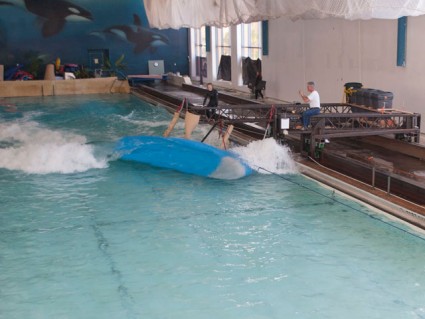
About three quarters of a million dollars of steel, girders, garbage cans, water, engineering and R and D (Sawed-off Chevy Silverado not included): The Flying Reef in motion proving the concept in the Belmont Park Plunge Natatorium, June of 2006. According to Tom Lochtefeld, this wave plow/wing/foil or whatever you want to call it is similar in concept to what pushes Kelly’s Beauty. Photo: courtesy Wave Loch
For the entire length of that Olympic-length, don’t-mess-with-a-California-state-historic-monument swimming pool were two steel girders fastened to the floor, running the length of the pool. Not a quarter mile, but still. Those girders supported a custom-welded, bomb-proof, metal-framed sled with garbage cans full of water counterbalancing a steel arm, which held a blue plow/blade-looking thing in the water. If OSHA (or officials from the California State Historical Society) had walked in at that point, they would’ve had a cow and arrested everyone. There were cranes and tools and power cords from both projects lying by pools of water. At the other end of the pool was a Chevy Silverado with the back end sawed off and big metal piping funneling the exhaust outside. The Silverado’s back end was fitted with big steel hubs with cables and ropes that ran the length of the pool to the wave sled or plow or whatever you want to call it.
Tom called it the “Flying Reef.”
Tom’s engineer, Chuck Sauerbier, was sitting in the driver’s seat of that Silverado, looking weird and ingenious like the Mad Hatter.
So the Flying Reef was in the water, the sled was on the girders, the garbage cans filled with water were counterbalancing and it was all ready to go. The engineer honked his horn once — “Ready!?” — and Carla balanced on the top of the Flying Reef with her surfboard ready. Then the engineer honked twice and put that Silverado in gear, and the pulleys pulled those cables tight, bringing that thing forward, and Carla leapt nimbly onto her board and rode the wave pushed in front of it. Carla rode that first one, and then Annie had a go. They both did their best to ride an artificial wave in the tight confines of an Olympic-sized pool. They nailed it, they flailed, they had fun. It was weird.
After each wave, the pool needed a good 10 minutes to settle down and de-slosh, and then the engineers ran the wave with no one riding it. That wave plow/sled/Flying Reef kicked up a tight, little barrel that looked kind of like those zipper waves that ran along the inner sandbar at the Santa Cruz Harbor back in the day. A perfect barrel, maybe two-feet high, and I remember thinking, “Wow, if they could only create that same wave at head-high for a distance…”
Fast forward almost 10 years to December 18th, 2015. Imagine the surprise when I, like the rest of the world, stumbled over the Kelly Slater Wave Co. video on Facebook, and there it was. Holy shit! It was that same perfect, tight, little barrel I had seen Frankenstein’d in the Belmont Park Plunge! But now it was head-high, in root-beer colored water (like the Queen Charlotte Islands), breaking somewhere in the middle of a cold, tree-lined nowhere.
Kelly Slater Wave Co. should get an Oscar or a Clio for how they revealed their wave to the world. A 3:40 clip, a few words from Kelly on the video, a few more words from Kelly on Instagram… that’s it. It was enough. Kelly and crew sat back and watched the Internet go berserk in a way usually reserved for Kim Kardashian’s okole, or Donald Trump inciting the proles with inflammatory rhetoric. After some clever Internet sleuths found that wave in Lemoore, near Fresno, I emailed the clip to a former Pepperdine student named Kelsey, who had grown up in Fresno. She knew the location right away: “Yes! I’m almost positive! The awning he is under at the beginning was the giveaway. It used to be called ‘Lago Del Sol,’ they had summer camps there when I was younger! Their Facebook says ‘permanently closed’ now, though.”
Kelsey was right. And the video was brilliantly done. Like a striptease, it reveals little, while leaving most to the imagination. Of all the wonderments in that video, the best is Kelly Slater’s reaction. Was he really seeing the wave for the first time? He’s been working on the wave with his team for 10 years, surely he’s seen it before. But if that reaction was feigned, then Kelly’s acting has taken a hyper leap since the Jimmy Slade days, and maybe he should have a Golden Globe along with all those World Titles.
Or maybe he really was seeing it for the first time. Kelly’s body English and facial expression complemented what the world was thinking. He jumped up and down like a little kid at Christmas, his mouth dropped in awe and his eyes lit up when he saw the impossible peeling across that wave pool in the middle of nowhere.
And then he rode it.
The repercussions and reverberations are huge. All this talk about surfing in the Olympics just got a lot more credible with a wave like that. And it’s also a kind of moving halfpipe. Guys and gals working on their airs and flips now have a powerful, reliable ramp to practice and make perfect, over and over.
That experiment with the Flying Reef almost 10 years ago was just a sliver of all the money and time and engineering that have been invested into making the perfect wave. That first wave sled and plow cost around $750,000. But that’s only a fraction of the money Murphy’s Waves, Wavegarden, American Wave Machines, Webber Wave Pools, the non-starting Ron Jon Surf Park, WaveLoch, SurfLoch, the now-extinct Ocean Dome, and God knows who else have invested in building their “perfect” waves.
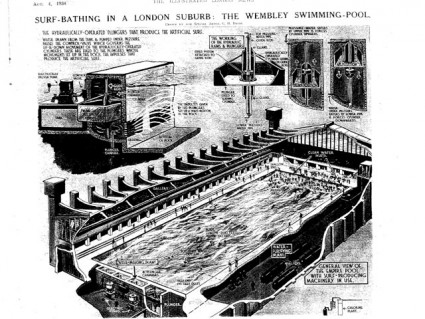
Wave pools are nothing new. Case in point: The Wembley Surf Pool, England, circa 1934. “The impulses given by the plungers have an accumulative affect on the water in the pool,” the ad said. “Building up waves which increase in size until, at the shelving shallow end, bathers may enjoy all the fun and exhilaration of surf bathing.” It took us — as in Kelly — 80 years to perfect it. Photo: courtesy Wave Loch
But the Kelly Slater Wave Company has done it, and it is indeed perfect.
After the Big Reveal, Kelly retreated to one of his Fortress of Solitudes around the world and enjoyed the holidays as he watched the world spin.
The guys at Wave Garden didn’t ceremonially drown themselves in their suddenly outclassed creation, as some snide commentators suggested. Tom Lochtefeld, for his part, has no hard feelings. He’s working on his own angle, and the success of Kelly Slater Wave Co. generates interest. Kelly’s email address, [email protected], has been bouncing back messages since October (and not just from the annoying me). So neither Kelly nor anyone at Kelly Slater Wave Co. was answering emails leading up to the new year.
Meanwhile, Tom Lochtefeld spoke from his own Fortress of Solitude, offering his thoughts:
“Slater’s wave is epic and definitely raises the bar… It appears that KSWC uses a cable-driven hull of some sort, similar to my moving reef technology, but I abandoned this moving foil approach about four years ago (after spending a boatload of $) for the following reasons:
1) Low wave frequency. (Rumor has it that Slater can only generate one quality wave every four minutes. In order to get the glassy conditions that you saw on the video, one needed to wait 15 minutes between waves.)
2) Basin turbulence and adverse secondary wave phenomena.
3) Lack of simultaneity — inability to deliver different waves to multiple surfers at the same time from the same energy pulse.
4) Wave adjustability — separate quality and size of waves to differing levels of surfers.
5) Moving parts in water — maintenance, reliability and fault tolerance problems.
6) Safety.
My hat’s off to KSWC, but making the perfect wave is not the hard part. The hard part is providing the investor who puts up the money sufficient financial return to justify his assumed risk. I have been chasing this economic Holy Grail for over 35 years. There are always trade-offs, but I believe I have found it. Surf Loch’s latest pneumatic (wind) technology makes the perfect wave, solves all the issues above and is economically viable. We are under construction in Rotterdam (opening third quarter 2016). Notwithstanding my reservations regarding the KSWC technology, I sent a text out to Kelly suggesting that we would be better off working together, combining our respective expertise, rather than as competitors. I hope he and I can connect in the near future. It’s a big world out there…plenty of places for Surf Pools.”
Even if Kelly were answering emails at [email protected], he probably wouldn’t answer anyway, but I — on behalf of the surfing and wave-engineering worlds — would like to ask the following questions:
1. How does that wave feel? What wave would he compare it to?
2. Was the wave modeled to replicate an existing wave?
3. What are they calling the gizmo that pushes all that perfection through the water?
4. How much energy does it take to pull that gizmo through the water?
5. Is the wave scaleable up or down?
6. Do they adjust the gizmo as the wave is moving to create the barrel, then back it off so he can do a cutback, then make it barrel again?
7. Why did they locate it in Lemoore?
8. What are the projections for sales?
9. Do they intend to commercialize that wave in the Central Valley, or is it just a test tank, a proof of concept?
10. How much would it cost to buy and install a wave pool similar to what they built in Lemoore?
11. Can it go left?
12. When will the first unit be open to the public?
Until we know these answers, the surf world will continue to wonder. (Since Kelly loves golf, imagine if he makes 18 different waves, like a golf course.)
Regardless, Kelly Slater has built a better mousetrap, and the world is ready to use it.
Captain Cook. Redwood. Tom Blake. The fin. Balsa wood. Fiberglass and resin. George Greenough. Cape St. Francis. The leash. Simon Anderson. The shaping machine… And now: Kelly’s Beauty.
Van Halen once sang: “Only time will tell if we’ll stand the test of time.”
But for now, this really is a big f***ing deal.


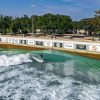
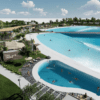
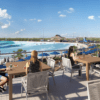
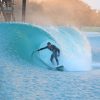

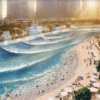
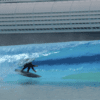
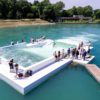


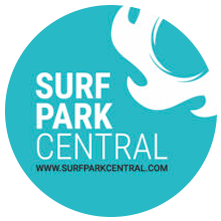




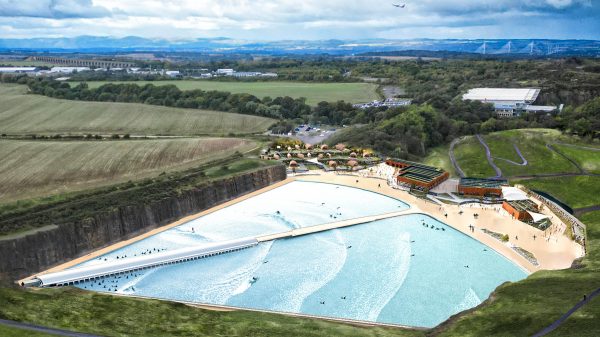
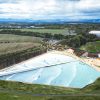
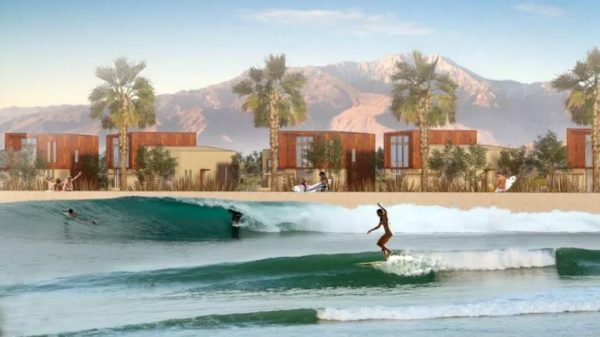
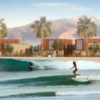
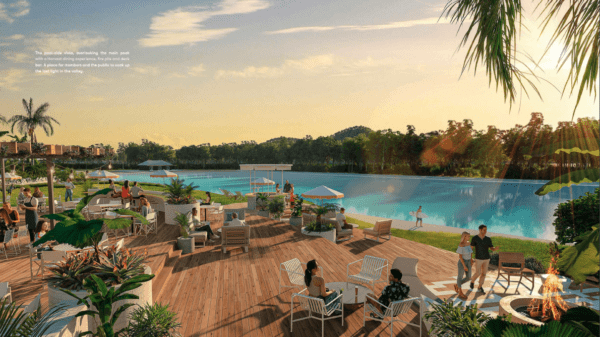
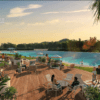
Pingback: Surf Parks and Man-Made Waves Proposed for Seaport Village SD